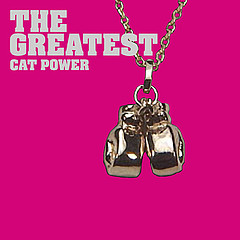

I’ve been holding on to this thing over a month now and I can’t really keep it to myself anymore. I’m talking about the upcoming
Cat Power release
The Greatest, schedule for official release in January. Being the obsessive Cat Power fan I acquired the leaked copy illegally, but rest assured, I plan on legally purchasing the album when it’s released. And not just because I’m an obsessive Cat Power fan; I’m purchasing it because it’s fucking awesome. As it stands,
The Greatest is the best album of 2006, and the year hasn’t even begun yet.
For the album, Chan surrounded herself with accomplished and well-versed Memphis musicians who give it an unprecedented feel and sound.
The Greatest finally provides Chan’s voice with a complementary backdrop and gives her, for the first time ever, some soul to share.
Marshall’s songs still bear the primitive feel of her earlier work. The arrangements roll alongside her, almost metaphorically like the Mississippi that borders Memphis. What’s strange is that this isn’t the first time she’s recorded in Memphis. Actually, Cat Power’s second album
What Would The Community Think was recorded there. Stuart Sikes, who engineered that album (and who most recently mixed
Loretta Lynn's "Van Lear Rose" release) returns to the Cat Power camp as the Producer for this release. The end result is not only Cat Power’s most polished record to date, it’s also her most comfortable sounding one.
Marshall starts the album with one of her best written songs, the title track “The Greatest.”
“Once I wanted to be the greatest
No wind or waterfall could stop me
And then came the rush of the flood
The stars at night turned you to dust”
This song sets the bar high for the entire album and throughout the record, she continually delivers and exceeds expectations.
The Greatest is the album that us Cat Power fans have been waiting for and it finally demonstrates her talent completely. We no longer have to make excuses for her and we no longer have to explain the idiosyncrasies that have plagued her image and performances in the past. With every meltdown from now on, we have
The Greatest to fall back on as a demonstration of what she can actually do with her talent with the right musicians and with the right formula.
Once again, but the arrangements provide her with subtle nuances that previous backing musicians haven’t been able to accomplish. Take
The Dirty Three who backed her on
Moon Pix. Their performances seemed to almost complement her depressive traits. This Memphis bunch, instead, bring a real depth to her emotions. From the light and somewhat joyous second track, “Could We,”
Hi Records guitarist
Teenie Hodges slinks along with the same effort as he did on the most famous song he helped compose, “Take Me To The River.”
They transform “Willie Deadwilder” (now titled as just “Willie”) into an airy stroll that knocks off about ten minutes from the original version on “Speaking For Trees.” While that original version brought tears to my eyes, there’s a strange sense of hope when she declares
“now my heart is a worried thing
memories are planted there
the seeds of the field
I now want to reap and sow.”
Sure, the words have been edited a tad, but the overall theme remains the same. It’s the effort of her Memphis band that transforms this song into something new, something extraordinary.
“Hate” revisits traditional Cat Power ground by using only a primitive strumming of Chan’s
Danelectro guitar as the accompaniment. But because the track comes late in the disc, the impact of this song is more noticeable.
“Living Proof” manages to do something never accomplished before in Cat Power albums: it gets a little funky. “You’re supposed to have the answer/you’re supposed to have living proof” she says on the track, and the answer is
The Greatest is the best Cat Power album yet and it should be referred to by music fans for years to come in the same way that we praised
Dusty Springfield for making her own way to Memphis over 35 years ago. Let’s hope Chan doesn’t make the mistake that Dusty did and never return back to these surroundings that have obviously lit a spark to her muse and helped her talent truly flourish.


